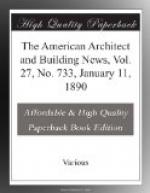An interesting verification of the remarkable non-heat condensing quality of the magnesia covering occurred at Lynn, Mass. In the heart of the district in that city, recently the scene of the disastrous conflagration, there was located the machine-shop of Messrs. Rollins & Glozier. A two-inch steam-pipe there was covered with this material. The heat of the fire at this place has been curiously determined to have been between the minimum extreme of 2,756 deg. Fah. and the maximum extreme of 2,950 deg. Fah., in this way: Cast-iron melts at 2,756 deg. Fah.; wrought-iron at 2,950 deg. Fah. A portion of the cast-iron bed of a lathe was fused into an irregular mass, and on it, partly imbedded, was a wrought-iron nut not melted. The steam-pipe spoken of fell a distance of 20 feet, and some of the magnesia covering was broken by the fall, but so effective was its heat-resisting and non-heat-conducting power that the pipe was found to be uninjured, and it is being used again in the building which is being erected to take the place of the one burned. That the magnesia should have endured the ordeal successfully was not unexpected, for we know that it is used by the Herreshoff Manufacturing Company as a lining to the shells of its coil boilers, and it is there subjected to a very intense heat resulting from the forced draught used in this type of boiler. Instances could be multiplied indefinitely, but I refrain from occupying further time with them, citing, however, one recent pertinent case.
The trial trip of the new cruiser “Baltimore” took place in the middle of September. It is reported to have been in many ways eminently satisfactory. The report goes on to state: “Another noteworthy fact was the comfortable condition of the fire and engine rooms. A duplicate crew had been provided with the expectation of relieving the firemen in two-hour turns; but after the first two hours of the run the first watch refused to quit work and insisted in running the ship throughout the entire four hours’ trial.” Boilers and all steam-surfaces were covered with the magnesia covering.
So it appears that not alone is the man who pays for the coal interested in this question of most perfect insulation, but also the men who operate the plant as well. In time, those architects, those mechanical engineers, those engine-builders and those other advisers, who are paid to advise soundly and correctly, and who are represented by our figure with the re-entering angles, will, of necessity, change their form and begin to assimilate these new facts, or ossification will so spread throughout the whole figure that they will be relegated to the shelf for curiosities as showing what strange geometrical forms the intellectual life of man may take.




